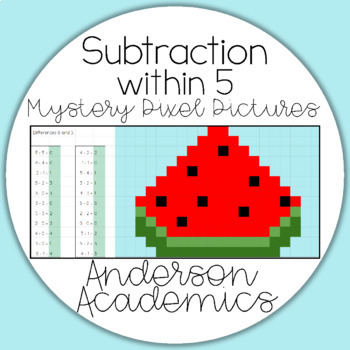Subtraction within 5 Math Pixel Puzzle (Watermelon)
Anderson Academics
909 Followers
Grade Levels
K - 1st
Subjects
Resource Type
Standards
CCSSK.OA.A.5
CCSS1.OA.C.6
Formats Included
- Google Sheets™
- Excel Spreadsheets
Pages
1 page
Anderson Academics
909 Followers

Made for Google Drive™
This resource can be used by students on Google Drive or Google Classroom. To access this resource, you’ll need to allow TPT to add it to your Google Drive. See our FAQ and Privacy Policy for more information.
Also included in
- This is a set of 6 self-checking addition and subtraction math pixel puzzles. This product is used through Google Slides (or can be downloaded as an excel spreadsheet). As students enter the correct answers, the answer boxes turn green and pixels of the mystery picture appear. The following topics aPrice $9.00Original Price $12.00Save $3.00
Description
This pixel puzzle requires students to solve subtraction equations with within 5. The puzzle is self-checking, as each answer box turns green when the correct difference is entered. Additionally, pixels of the mystery picture are revealed with each correct answer. When the equations are correctly solved, the picture reveals a watermelon slice.
This puzzle is also included in https://www.teacherspayteachers.com/Product/Addition-Subtraction-within-10-Pixel-Puzzle-Bundle-6253435Addition & Subtraction within 10 Pixel Puzzle Bundle!
Total Pages
1 page
Answer Key
Included
Teaching Duration
N/A
Report this resource to TPT
Reported resources will be reviewed by our team. Report this resource to let us know if this resource violates TPT’s content guidelines.
Standards
to see state-specific standards (only available in the US).
CCSSK.OA.A.5
Fluently add and subtract within 5.
CCSS1.OA.C.6
Add and subtract within 20, demonstrating fluency for addition and subtraction within 10. Use strategies such as counting on; making ten (e.g., 8 + 6 = 8 + 2 + 4 = 10 + 4 = 14); decomposing a number leading to a ten (e.g., 13 - 4 = 13 - 3 - 1 = 10 - 1 = 9); using the relationship between addition and subtraction (e.g., knowing that 8 + 4 = 12, one knows 12 - 8 = 4); and creating equivalent but easier or known sums (e.g., adding 6 + 7 by creating the known equivalent 6 + 6 + 1 = 12 + 1 = 13).






